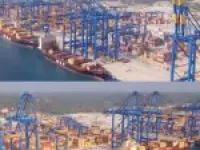
(image: x.com/PortOfVizhinjam)
Thiruvananthapuram: Vizhinjam International Seaport, touted as the first international deep-water transshipment port in the Indian subcontinent, is to be inaugurated by Prime Minister Narendra Modi on May 2. Since its commencement, the project has been mired in debates and allegations. As political parties — CPI(M) and Congress — vie to take credits for helming the project, capital city once witnessed extensive protests from coastal communities questioning the construction of the port stressing the environmental ramifications that the project would bring.
As the deep-sea port is about to open a new era in maritime trade, let’s look at the journey marred by controversies.
Also Read | Adani Group’s Vizhinjam Port: Why The Development Is A Big Deal
Vizhinjam Port Project: Brief Overview
The initial discussions on setting a port in Vizhinjam can be traced to 1990. However, the project began in 2015 after the erstwhile Oommen Chandy government inked a deal with Adani Group.
The Rs. 7,600-crore project is being constructed on a public-private-partnership (PPP) mode with funding from the Kerala government, Centre and the Adani Ports Private Limited being the developer. The State government under the DBFOT (Design, Build, Finance, Operate, and Transfer) model, gave the contract to the Adani Ports and Special Economic Zone (SEZ) Private Limited for designing, building, financing, operating, and eventually transferring the port project. The Kerala government gave 500 acres of land for this project. As per the DBFOT deal, the Adani Group has a 40-year agreement to develop and operate the Vizhinjam port.
The Vizhinjam transshipment project holds significance for its strategic location, with respect to International East-West shipping route. The first Greenfield port project in India, once fully commissioned, will be well-equipped to compete with international ports in Colombo, Singapore and Dubai. As per reports, the construction of all the phases of the port will be completed by 2028.
Allegations Of Corruption And Credit War
Though the construction of this port began during the term of Oommen Chandy government, majority of the construction developed during the past two terms of Pinarayi Vijayan led-LDF government. When the Congress government entered a deal with Adani Group, CPI(M), which was then in Opposition objected to it and alleged that it was land scam at the cost of jeopardising the livelihood of the fishing community. Pinarayi Vijayan, who was then CPI(M) Polit Bureau member claimed that Oommen Chandy committed a Ra 6,000 crore corruption in Vizhinjam.
Later, when the Vijayan government came into power, it ordered a judicial probe over the project. The three-member judicial commission which inquired into the allegations, had concluded that there was ‘no corruption associated’ involved with the project and that there was ‘no misuse of political power’.
Now, the Congress is accusing the Vijayan government of taking the credit for the project. Interestingly, in the inaugural speech held over the commencement of the trial operations at Vizhinjam, Chief Minister Vijayan skipped to mention Oommen Chandy or Congress government’s contributions and only detailed the efforts different LDF governments undertook for the port.
A Protest Went Unheeded
The idea of port in Vizhinjam erupted protests and agitations in the coastal areas of Kerala’s capital. The anti-port protests by local fisherfolk was helmed by the Thiruvananthapuram archdiocese of the Latin Catholic Church. Protesters stated that the deep-sear project is causing loss of habitat, livelihoods, and biodiversity.
The protest started on 5 June (World Environment Day) 2022 and the site moved to Adani’s Vizhinjam port gate on August 16. Their seven-point demands included: an impact study; rehabilitation of families who lost their homes to sea rage; compensation for loved ones in fishing accidents; financial aid to fisherfolk on days weather warnings are issued; subsidised kerosene; a mechanism to dredge the Muthalappozhi fishing harbour in Anchuthengu; and effective steps to mitigate coastal erosion.
In the last week of November 2022, protest turned violent as the conflict between the police and the agitators went out of line. The scale of violence put the protestors in negative light since it involved vandalism, injuring police personnel and damaging the police property. There were also apprehensions that communal polarisation was slowing seeping in the coastal belt, with several religious groups supporting the project, which shifted the narrative of the agitation to a communal angle. An organised hostility towards the protesting fishing people began to emerge, and they have been labelled rioters, traitors, terrorists, Chinese spies, and agitators funded by Sri Lanka. The protesting fisherfolk were also accused of receiving foreign funds to stage the protest and sabotage the project.
Also Read | Adani Group’s Vizhinjam Port Welcomes First Mothership; Kerala Creates History
Thus, realising the change of circumstances, surmounting pressures and government’s defiant stance, on December 6, Latin Church suspended a four-month long fisherfolk agitation against the Adani port project. With protest being called off, it later presented by the ruling government as their success in firmly handling the roadblocks and unflinching attitude of the chief minister Vijayan in deftly handling the crisis.
The ambitious project is going to be presented as a success story of the State and both ruling and opposition parties are competing to claim credit for it. However, the real question is how the disruptions caused by the project are going to reshape the coastal climate of Vizhinjam, one of the largest fishing village in Kerala.













